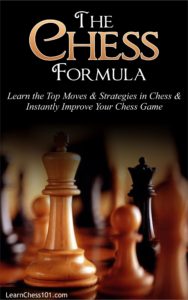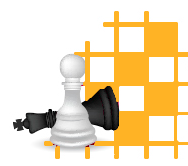Chess Match Victory Lesson- Chess Strategy 101
Chess Match Victory Lesson
Chess Strategy 101
The following video is a recent chess match I played against an opponent. As I covered in previous articles, while it’s rare to beat an opponent in only a few moves, implementing basic strategy and following various techniques is the sure way to consecutively win chess matches. I cover this more in my new E-book “The Chess Formula”.
As covered in the chess strategy article, as well the The Chess Formula, in this match, I follow fairly simple principles:
- Capture my opponent’s unprotected pieces
- Pay attention to future moves
- As well as some strategies covered in the E-Book.
[wpdevart_youtube]zrZXQp2ONYc[/wpdevart_youtube]
Notes about this chess match
53 seconds – I had captured my opponent’s Knight. It is never an ideal situation to have your opponent’s knight in your territory. This may result in checkmate, or cause one of your pieces to be captured without capturing in return. It’s best to capture an opponent’s piece as soon as possible when in this scenario.
1:18 – I had moved my queen in position not to capture the rook, but to capture the pawn, which I do at 1:42. As mentioned in previous articles, never under estimate the pawns, and always be sure to value your own. This one move would be critical at the end of the match, when I began moving my pawn toward the other end of the chessboard to be promoted to queen. Without that pawn in the way, it becomes a much greater hassle for my opponent.
1:25 – I had my opponent’s bishop trapped to be captured by a pawn regardless of his move. Rather than capture it on the following move, I move the pawn in front of my rook forward, preventing my opponent’s bishop from placing the King in check. On the following move, then I capture the bishop.
2:06 – I made the mistake of placing my rook in the bishop’s line of capture, rather than moving my knight as I do on the following move. While this was really only the mistake made during the match, always be sure to check the chessboard prior to moving.
2:44 – opponent had placed me in a position which may have caused me to lose at least 1 of my high value pieces, however, by not immediately reacting and looking over the chessboard, I was able to save both pieces.
3:18 – In terms of high value pieces, I don’t have too much of an advantage over my opponent. However, I outnumber my opponent’s pawns 7-3. I begin moving the pawn in front of my rook forward to be promoted. This move is what creates the greatest advantage over my opponent. I’ll either gain a queen, or my opponent will have to capture the pawn with their rook, and lose the rook to a pawn.
3:50 – Opponent resigns
Take your chess game to the next level with the E-Book “The Chess Formula: Learn the Top Moves & Strategies in Chess & Instantly Improve Your Chess Game”. The book is designed to teach both offensive and defensive chess strategies simultaneously, in a simple and easy to follow manner.




